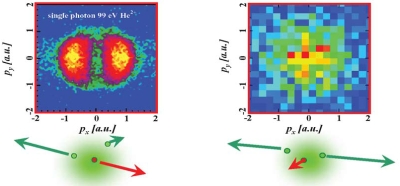Density plot of recoil-ion momentum (left: One photon absorption of He2+; right: Two photon double ionisation. The Ne2+ pattern representing the vector sum-momentum distribution of the two electrons). (Credit: MPG Heidelberg Press release)
Scientists from the Max Planck Institute for Nuclear Physics in Heidelberg, their collaborators from DESY, from the University of Frankfurt and other institutes reported on non-sequential few-photon multiple ionization of Ne and Ar Atoms by intense FLASH radiation. Few-photon multiple ionization, i.e. the interaction of two or three photons with two or three electrons bridges the gap between the single and multi-photon regime and, thus, is of decisive importance to advance non-linear theories.
They used multiparticle detection systems, a dedicated ‘reaction microscope’ for their measurements at FLASH. Ions and electrons were guided to two positionsensitive channel plate detectors by weak electric and magnetic fields, and from the measured time-of-flight and positions on the detector the full momentum vectors were calculated.
The light-intensity dependence for ion-yields confirmed double ionization of Ne to be mainly due to two-photon nonsequential ionization at high intensities. The recoil-ion momentum distributions suggest that two electrons absorbing ”instantaneously” two photons are ejected most likely into opposite hemispheres with similar energies.
(...Annual report/Paper)
Their results appeared in Physical Review Letters (May 14, 2007).
| Further Links |
|






